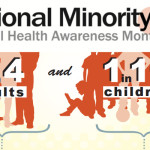By SAMHSA
By: Jorielle R. Brown, Ph.D., Director, Division of Systems Development, Center for Substance Abuse Prevention, Substance Abuse and Mental Health Services Administration; and David J. Johns, M.A., Executive Director, White House Initiative on Educational Excellence for African Americans
In 2013, there were more than 41,000 deaths as a result of suicide in the U.S. Suicide is the tenth leading cause of death, claiming more lives each year than death due to motor vehicle crashes. Especially alarming, it is the second leading cause of death for young people age 10 to 24.
Suicide rates vary considerably within different population subgroups and are affected by factors such as socioeconomic status, employment, occupation, sexual orientation, and gender identity. For example, the rates of suicide were almost four times higher for men than for women and were highest among Whites. In 2013, suicide rates were 11.7 per 100,000 for American Indians/Alaska Natives, 6.0 per 100,000 for Asians/Pacific Islanders, 5.3 per 100,000 for Hispanics, and 5.4 per 100,000 for African Americans.
However, racial and ethnic disparities can be deceptive.
In July of this year, JAMA Pediatrics![]() published a research paper analyzing childhood suicide trends from 1993 to 2012. One critical issue the authors found was that while school-aged suicide trends have stayed constant, trends on a racial level have changed substantially. In fact, the stable overall suicide rate has “obscured a significant increase in suicide incidence in black children.”
published a research paper analyzing childhood suicide trends from 1993 to 2012. One critical issue the authors found was that while school-aged suicide trends have stayed constant, trends on a racial level have changed substantially. In fact, the stable overall suicide rate has “obscured a significant increase in suicide incidence in black children.”
Obviously, this finding is concerning on many levels. However, more research is needed to understand the risk and protective factors for African American children and youth and to see if they are experiencing more exposure to violence, traumatic stress, and/or aggressive school discipline. Another example where more research is needed includes studies on earlier puberty in African American children to determine whether it is a risk for depression, suicidal ideation, and suicide attempts. Also, more knowledge is needed from the research lens to determine if there is sufficient evidence that religiosity and social support are in fact protective factors for this population or if the protective factors have changed over time.
It is essential to understand how culture and identity impact development and health. The White House Initiative on Educational Excellence for African Americans visits communities around the country to engage with students, families, educators and other partners to better understand how we can work collectively to support African American students. Toxic stress in urban communities as well as stressors such as micro aggressions in affluent ones are regularly raised as issues by students and the caring adults who support them. According to The National Institutes of Health, one in three![]() African Americans who need mental health care receive it. To support President Obama’s goal of restoring the country to its role as the global leader in education, and to improve educational outcomes for African Americans of all ages, we must address mental health concerns.
African Americans who need mental health care receive it. To support President Obama’s goal of restoring the country to its role as the global leader in education, and to improve educational outcomes for African Americans of all ages, we must address mental health concerns.
Learning the answers to these and other questions will help us address this troubling trend. Suicide is a serious and preventable public health problem in the United States. SAMHSA is working with our partners across the country on suicide prevention, but we know that we cannot do this work alone and need the help of educators, parents, brothers, sisters, pastors, and many others. Please consider joining the National Action Alliance for Suicide Prevention![]() . Also know the signs of suicidal behavior and seek help by contacting the National Suicide Prevention Lifeline
. Also know the signs of suicidal behavior and seek help by contacting the National Suicide Prevention Lifeline![]() if you or someone you know is thinking about attempting suicide. If you don’t know where to find help, SAMHSA can help you find local resources for behavioral health through the Behavioral Health Treatment Services Locator and our toll free helpline 1-800-662-HELP(4357). If you are part of the healthcare and social services workforce, download our newest suicide prevention app Suicide Safe. Together we must address and work to decrease and eliminate suicide in all populations.
if you or someone you know is thinking about attempting suicide. If you don’t know where to find help, SAMHSA can help you find local resources for behavioral health through the Behavioral Health Treatment Services Locator and our toll free helpline 1-800-662-HELP(4357). If you are part of the healthcare and social services workforce, download our newest suicide prevention app Suicide Safe. Together we must address and work to decrease and eliminate suicide in all populations.
Via:: Suicide and Race












